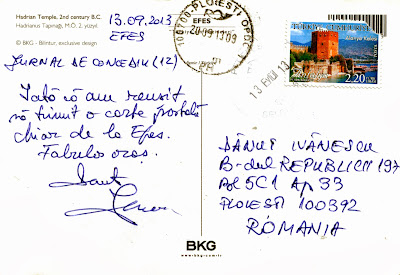 |
| 0827 Ephesus - The Library of Celsus |
Founded as an Attic-Ionian colony in the 10th century BC, on the site of the Bronze Age city Apasa, Ephesus was famed for the Temple of Artemis (completed around 550 BC), one of the Seven Wonders of the Ancient World. Around the year 650 BC it was conquered by the Lydians, and in the middle of the 6th century BC was incorporated into the Achaemenid Empire, but in 479 BC the Ionians, together with Athens, overthrew the Persians. In 356 BC the temple was burned down, according to legend, by a lunatic, being restored by inhabitants.
 |
| 0828 Ephesus - Hadrian Temple |
A few decades after Alexander the Great liberated the city, the river Cayster silted up the harbor and the inhabitants were forced to move to a new settlement, 2km further on. In the next period Ephesus became part of the Seleucid Empire, then came under Egyptian rule, and finally under the one of the king of Pergamon, later being one of the largest cities of Roman Asia Minor. The city and temple were destroyed by the Goths in 263 AD, and this marked the decline of its splendor.
 |
| 0829 Ephesus - Heracles Gate |
Rebuilt by Constantine I, it remained the most important city of the Byzantine Empire in Asia after Constantinople in the 5th and 6th centuries, till was again partially destroyed by an earthquake in 614. Its importance declined when the harbor was silted up (today, it is 5km inland). Sacked by the Arabs several times, and conquered by Seljuk Turks in 1090, it returned in 1097 under the control of Byzantine Empire, which kept it until 1308. Incorporated into the Ottoman Empire for the first time in 1390, and for the second in 1425, it was completely abandoned in the 15th century. Nearby Ayasuluğ was renamed Selçuk in 1914.
 |
| Entrance ticket to Ephesus (2013) |
 |
| Entrance ticket for children (free) to Ephesus (2013) |
Built in honor of the Tiberius Julius Celsus Polemaeanus, an Ancient Greek who served as governor of Roman Asia (105-107) in the Roman Empire, Library of Celsus was completed in 135 AD by Celsus' son, consul Gaius Julius Aquila. Celsus paid for the construction of the library with his own personal wealth, and is buried in a sarcophagus beneath it. It once held nearly 12,000 scrolls. The interior of the library and all its books were destroyed by fire in the devastating earthquake that struck the city in 262.
Only the façade survived, but was in its turn destroyed by a later earthquake, likely in the late Byzantine period. At about 400 AD, the library was transformed into a Nymphaeum, a monument consecrated to the nymphs, especially those of springs. The façade was reconstructed from all original pieces between 1970 and 1978. The style of the library reflects the Greek influence on Roman architecture. The building materials, brick, concrete, and mortared rubble, signify the new materials that came into use in the Roman Empire around the 2nd century AD.
Built before 138 AD by P. Quintilius, and dedicated to the Emperor Hadrian, who came to visit the city from Athens in 128 AD, Temple of Hadrian is one of the best preserved and most beautiful structures on Curetes Street. The facade of the temple has four Corinthian columns supporting a curved arch, in the middle of which contains a relief of Tyche, goddess of victory. The pedestal with inscriptions in front of the temple, are the bases for the statues of the emperors between 293-305 CE, Diocletian, Maximian, Constantius I, and Galerius (the originals haven't been found yet).
Inside the temple above the door, stands the figure of Medusa, with ornaments of acanthus leaves. On both sides there are friezes depicting the story of the foundation of Ephesus (Androklos shooting a boar, Dionysus in ceremonial procession and the Amazons). The fourth frieze portrays two male figures (one of which is Apollo), a female figure, Androkles, Herakles, the wife and son of Theodosius and the goddess Athena. The friezes that are seen today are copies, and the originals are displayed in Ephesus Museum.
Located towards the end of the Curetes Street, Hercules Gate was called so because of the relief of Hercules on it. It was brought from another place in the 4th century AD to its current place, but the relief on it dates back to the second century AD. Only the two side of the columns remain today and the other parts of it have not been found. It narrowed the access to the street, preventing the passage of vehicles. In these reliefs Heracles was depicting with the skin of the Nemean lion in myhtology.
About the stamps
Unfortunately, the first and the third postcard have only a postmark with the value of the postal fees. The second, depicting the Alanya Castle, is part of the series Tourism - Antalya, issued on April 12, 2013, and consists of six stamps with the same face value (2.20 TRY).
References
Ephesus - Wikipedia
Ephesus - History, information and pictures of Ephesus Ancient city
Sender 0827, 0828, 0829: Dănuţ Ivănescu
0827, 0829: Sent from Didim (Aegean Region / Turkey), on 13.09.2013
0828: Sent from Selçuk (Aegean Region / Turkey), on 13.09.2013



No comments:
Post a Comment